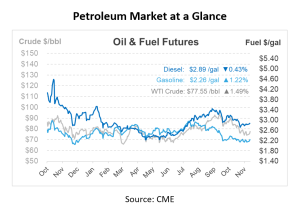
What is it – Fuel Viscosity
One key component but often overlooked aspect of diesel fuel is its viscosity. This term may sound complex, but it plays a significant role in ensuring the functionality and efficiency of diesel fuel, especially considering the regulations set forth by the American Petroleum Institute (API). So, what is fuel viscosity, and how does it come into play with diesel fuel? Let’s find out.
What is it?
Viscosity refers to a fluid’s resistance to flow. When it comes to diesel fuel, it is what determines how smoothly the fuel can move through various engine parts such as fuel lines, injectors, and pumps. The viscosity of diesel is influenced by factors like temperature, chemical composition, and the presence of additives. Fuel that is excessively viscous can lead to damage in the fuel pump, such as wear on the cam and follower, due to the increased pressure. Conversely, fuel with too low viscosity may result in inadequate lubrication. It also plays a role in determining the fuel delivery rate and the quality of fuel atomization during the injection process.
How does the API get thrown into the mix?
The API is a renowned organization in the petroleum industry that sets forth standards and specifications to maintain the quality and effectiveness of petroleum products, including diesel fuel. While the API primarily focuses on characteristics related to combustion, lubricity, and cetane number, viscosity is still a crucial aspect to consider. API gravity, which measures a liquid’s density in comparison to water, is not a direct representation of diesel fuel’s viscosity. Instead, API gravity categorizes fuels based on their density, such as light, medium, or heavy.
Kinematic is commonly used when measuring the viscosity of diesel fuel. Represented by the Greek letter “ν” (nu), kinematic viscosity is a ratio of the fuel’s density to its dynamic viscosity, typically measured in centistokes (cSt) or millimeters squared per second (mm²/s).
Classifications or Grades
Diving deeper, the API has defined a series of viscosity grade classifications for diesel fuel, known as the “C” series, ranging from “CA” to “CZ.” These grades provide a standardized scale to determine the fuel’s viscosity at 40°C (104°F), with the viscosity increasing from “CA” to “CZ.”
Why is all this important, you ask? Well, the API’s data is a valuable resource for end users, fuel suppliers, and engine manufacturers alike. It plays a crucial role in ensuring that diesel fuel meets the necessary standards for optimal engine performance. By adhering to the API’s recommended viscosity grade, engine components can run more efficiently, reducing the risk of wear and tear, fuel system issues, and potential engine damage.
What is the difference in viscosity between gasoline and diesel fuel?
Gasoline and diesel fuel exhibit distinct viscosities owing to their unique chemical compositions. Gasoline, characterized by its relatively low viscosity, is lighter and less dense than diesel fuel, facilitating easy vaporization and rapid combustion. On the other hand, diesel fuel is marked by a higher viscosity compared to gasoline, a result of its denser composition and larger hydrocarbon molecules, which render it thicker and heavier. The elevated viscosity of diesel is integral to the seamless functioning of diesel engines, providing essential lubrication to fuel pump and injector components. In essence, while gasoline is a low-viscosity fuel that readily vaporizes and combusts, diesel stands out as a high-viscosity fuel that ensures the requisite lubrication for the components of diesel engines.
Biodiesel and Renewable Diesel
Biodiesel tends to have a higher viscosity than traditional diesel fuel. This is because biodiesel is made from vegetable oils or animal fats, which are thicker than the petroleum-based hydrocarbons in diesel fuel. The high viscosity of biodiesel can cause issues with fuel atomization and combustion in diesel engines, which is why it is often blended with traditional diesel fuel to create a biodiesel blend.
Renewable diesel, on the other hand, has a viscosity that is more similar to traditional diesel fuel. Renewable diesel is made from the same types of feedstocks as biodiesel, but it is processed in a way that removes impurities and produces a fuel with properties similar to traditional diesel fuel. As a result, renewable diesel can be used as a drop-in replacement for traditional diesel fuel without any modifications to the engine or fuel system.

This article is part of Daily Market News & Insights
Tagged: fuel lines, Fuel Viscosity, injectors, pumps
MARKET CONDITION REPORT - DISCLAIMER
The information contained herein is derived from sources believed to be reliable; however, this information is not guaranteed as to its accuracy or completeness. Furthermore, no responsibility is assumed for use of this material and no express or implied warranties or guarantees are made. This material and any view or comment expressed herein are provided for informational purposes only and should not be construed in any way as an inducement or recommendation to buy or sell products, commodity futures or options contracts.





